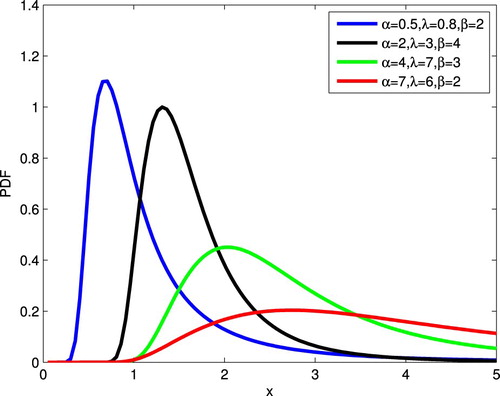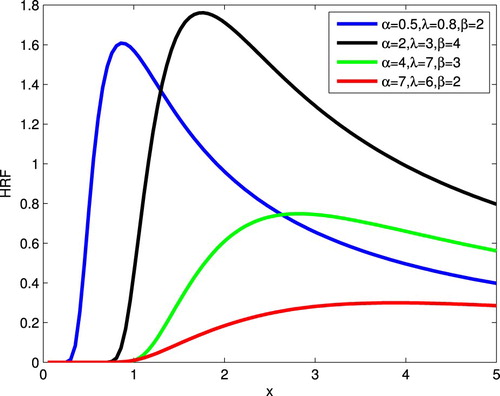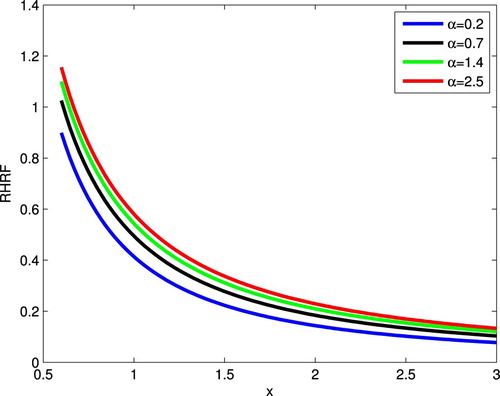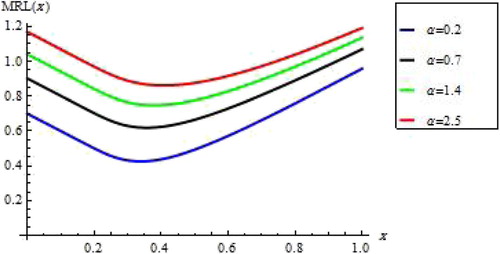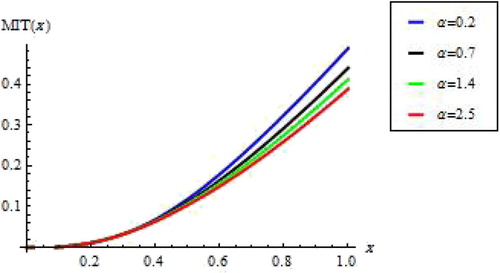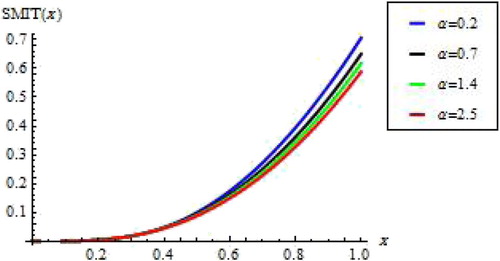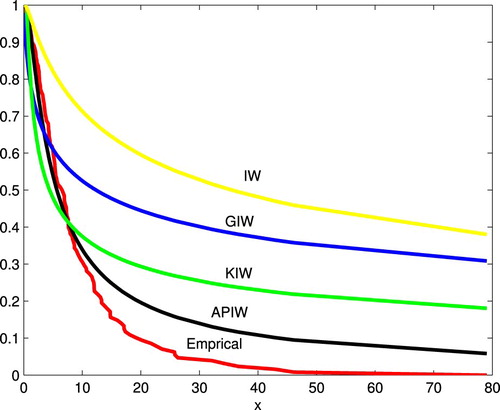 ?Mathematical formulae have been encoded as MathML and are displayed in this HTML version using MathJax in order to improve their display. Uncheck the box to turn MathJax off. This feature requires Javascript. Click on a formula to zoom.
?Mathematical formulae have been encoded as MathML and are displayed in this HTML version using MathJax in order to improve their display. Uncheck the box to turn MathJax off. This feature requires Javascript. Click on a formula to zoom.Abstract
In this paper, we use the method of the alpha power transformation to introduce a new generalized alpha power inverse Weibull (APIW) distribution. Its characterization and statistical properties are obtained, such as reliability, moments, entropy and order statistics. Moreover, the estimation of the APIW parameters is discussed by using maximum likelihood estimation method. Finally, the application of the proposed new distribution to a real data representing the waiting time before customer service in the bank is given and its goodness-of-fit is demonstrated. In addition, comparisons to other models are carried out to illustrate the flexibility of the proposed model.
1. Introduction
The inverse Weibull (IW) distribution plays an important role in many applications, including the dynamic components of diesel engine and several data set such as the times to breakdown of an insulating fluid subject to the action of a constant tension, see Nelson [Citation1]. Inverse Weibull distribution with parameters λ and β with cumulative distribution function and the probability density function of a random variable X are respectively given by
(1)
(1) and
(2)
(2)
A lot of work has been done on inverse Weibull distribution, for example, Calabria and Pulcini [Citation2] have studied the maximum likelihood and least square estimation of the inverse Weibull distribution. Calabria and Pulcini [Citation3] have studied Bayes 2-sample prediction for inverse Weibull distribution. Maswadah in [Citation4] has the fitted inverse Weibull distribution to the flood data. Some important theoretical analysis of the inverse Weibull distribution was studied by Khan et al. [Citation5].
In the recent past, many generalizations of inverse Weibull distribution have been studied by authors such as mixture of two inverse Weibull distributions by Sultan et al. [Citation6], the generalized inverse Weibull distribution by De Gusmao et al. [Citation7], modified inverse Weibull distribution by Khan and King [Citation8], beta inverse Weibull by Hanook et al. [Citation9], gamma inverse Weibull distribution by Pararai et al. [Citation10], Kumaraswamy modified inverse Weibull distribution by Aryal and Elbatal [Citation11], reflected generalized beta inverse Weibull distribution by Elbatal et al. [Citation12] and Marshall–Olkin extended inverse Weibull distribution by Okasha et al. [Citation13].
On the other hand, Mahdavi and Kundu [Citation14] proposed a transformation of the baseline (CDF) by adding a new parameter to obtain a family of distributions. The proposed method is called alpha power transformation (APT). If be a cumulative density function of any distribution, then the
is cumulative density function distribution
(3)
(3) and the corresponding probability density function (PDF) as
(4)
(4)
The main aim of this paper is to propose and study a new distribution model called APIW distribution based on the method of APT. The rest of the paper is organized as follows. In Section 2, we define our proposed model and its special cases are presented. In Section 3, its reliability analysis is given. In Section 4, its statistical properties are given. The parameters of this distribution are estimated by the maximum likelihood estimation (MLE) method in Section 5. Finally, the proposed model is applied on real data and the results are given in Section 6.
2. New model
In this section, we will give the alpha power inverse Weibull (APIW) distribution and some of its submodels.
2.1. APIW specification
Let and by substitution the cumulative function of inverse Weibull given by (Equation1
(1)
(1) ) in alpha power is given by (Equation3
(3)
(3) ) we get a new distribution denoted as APIW
distribution with CDF given by
(5)
(5) its corresponding probability density function (PDF) is given by
(6)
(6)
By using the Taylor's series expansion of the function , we can rewrite the PDF when
as follows:
(7)
(7)
Figure gives the graphical representation of PDF for different values of α, λ and β.
2.2. APIW submodels
Equation (Equation5(5)
(5) ) of the APIW distribution includes the following well-known distributions as submodels.
If
, then (Equation5
(5)
(5) ) reduces to alpha power Fréchet (APF) distribution.
If
, then (Equation5
(5)
(5) ) reduces to alpha power inverse Rayleigh (APIR) distribution.
If
, then (Equation5
(5)
(5) ) reduces to alpha power inverse exponential (APIE) distribution.
If
, then (Equation5
(5)
(5) ) reduces to inverse Weibull (IW) distribution.
If
and
, then (Equation5
(5)
(5) ) reduces to Fréchet (F) distribution.
If
and
, then (Equation5
(5)
(5) ) reduces to inverse Rayleigh (IR) distribution.
If
and
, then (Equation5
(5)
(5) ) reduces to inverse exponential (IE) distribution.
3. Reliability analysis
The reliability function (survival function) of APIW distribution is given by
(8)
(8)
3.1. Hazard rate function
The hazard rate ( HR) function (failure rate) of a lifetime random variable X with APIW distribution is given by
(9)
(9)
Figure gives the graphical representation of HRF for different values of α, λ and β.
3.2. Reversed hazard rate function
The reversed hazard rate (RHR) function of a lifetime random variable X with APIW distribution is given by
(10)
(10) Figure gives graphical representations of RHRF for different values of α.
3.3. Mean residual life
The mean residual life (MRL) function describes the aging process, so it is very important in reliability and survival analysis. The MRL function of a lifetime random variable X is given by
Theorem 3.1
The MRL function of a lifetime random variable X with APIW is given by
(11)
(11)
Proof.
From definition of MRL, we get
put
, thus
where
, c>0.
Figure gives graphical representations of MRL for different values of α.
3.4. Mean inactivity time
The mean inactivity time (MIT) function is a recognized reliability measure which has applications such as forensic science, reliability theory and survival analysis. The MIT function of a lifetime random variable X is given by
Theorem 3.2
The MIT function of a lifetime random variable X with APIW is given by
(12)
(12)
Proof.
Using the proof of MRL and the relation , c>0,
we get the above result.
Figure gives graphical representations of MIT for different values of α.
3.5. Strong mean inactivity time
The strong mean inactivity time (SMIT) is a new reliability function which was proposed by Kayid and Izadkhah [Citation15]. The SMIT function of a lifetime random variable X is given by
Theorem 3.3
The SMIT function of a lifetime random variable X with APIW is given by
(13)
(13)
Proof.
Using the proof of MRL and the relation , c>0,
we get the above result.
Figure gives graphical representations of SMIT for different values of α.
Table gives the values of HR, MRL, RHR and MIT(SMIT) for the selected values of ,
and t=0.6 and for different values of the parameter α. One can observe that the values of HR are decreasing and values of MRL are increasing and the same for RHR and MIT (SMIT).
Table 1. Some reliability of APIW for selected values of λ=0.7 and β=1.8 at t=0.6.
3.6. Stress–strength reliability
In the reliability, the stress–strength (supply–demand) model describes the life of a component which has a random strength X that is subjected to a random stress Z. The component fails at the instant that the stress applied to it exceeds the strength, and the component will function satisfactorily whenever X>Z. Hence, is a measure of component reliability. It has many applications in several areas of engineering and science.
We now derive the reliability R when X and Z have independent APIW () and APIW (
) distributions with the same shape parameter β. The PDF of X and the CDF of Z can be expressed from respectively as
and
We have
by using the Taylor's series expansion of the function , we obtain
then
(14)
(14)
3.6.1. Maximum likelihood estimation of R
We estimate the stress–strength parameter for the APIW distribution, assuming that APIW(
and
APIW
. Let
and
be independent observations from APIW(
) and APIW(
) respectively.
The total likelihood function is given by
The total log-likelihood is given by
(15)
(15)
By taking the first partial derivatives of the total log-likelihood with respect to the five parameters
(16)
(16)
(17)
(17)
(18)
(18)
(19)
(19) and
(20)
(20)
The maximum likelihood estimation of parameters is obtained by solving the system of nonlinear equations (Equation16(16)
(16) )–(Equation20
(20)
(20) ) numerically. From the solution of these equations, we can estimate R by inserting the estimate parameters in equation (Equation14
(14)
(14) ).
3.6.2. Real data analysis
In this section, we present the analysis of real data, partially considered in Ghitany et al. [Citation16], for illustrative purpose. The data represent the waiting times (in minutes) before customer service in two different banks. The data sets are presented in Tables and . Note that n=100 and m=60. We are interested in estimating the stress–strength parameter where
denotes the customer service time in bank A (B).
Table 2. Waiting time (in minutes) before customer service in bank A.
Table 3. Waiting time (in minutes) before customer service in bank B.
We solve equations (Equation16(16)
(16) )–(Equation20
(20)
(20) ) by mathematical package such as Mathcad to get the MLEs of the unknown parameters.
Table 4. Estimates of the stress–strength parameters.
4. Statistical properties
In this section, we study the statistical properties of the APIW, specially quantiles, moments, moment generating function, entropy, order statistics, stochasticorderings.
4.1. Quantiles
The quantile of any distribution is given by solving the equation
(21)
(21) The following theorem gives the quantile of APIW distribution.
Theorem 4.1
If X has APIW distribution, then the quantile of a random variable X is given by
(22)
(22)
Proof.
By assuming , the CDF of APIW can be written as
.
The quantile function is obtained by solving
and the obtained result in by solving for x we get
.
Table gives the quantiles for the selected values of and
and for different values of the parameter α.
Table 5. Quantiles of APIW for selected values of 
 and
and 
 .
.
Also, we can generate APIW random variable by using (Equation22(22)
(22) ).
4.2. Moments
In this section, we will present the moments of APIW distribution. Moments are important in any statistical analysis.
Theorem 4.2
If X has APIW distribution, then the
moment of a random variable X is given by
(23)
(23)
Proof.
From definition of moments and using (Equation7(7)
(7) ), we get
put
. Thus
Table gives the moments of APIW for selected values of and
and for different values of parameter α.
Table 6. Moments of APIW for selected values of λ=0.7 and β=5.
4.3. Moment generating function
The moment generating function of a random variable X provides the basis of an alternative route to analytic results compared with working directly with the cumulative distribution function or probability density function of X.
Theorem 4.3
If X has APIW distribution, then the moment generating function of a random variable X is given by
(24)
(24)
Proof.
We have
by using the Taylor's series expansion of the function
, we obtain
using the same proof of moments, we get the above result.
4.4. Entropy
In many field of science such as communication, physics and probability, entropy is an important concept to measure the amount of uncertainty associated with a random variable X. Two popular entropy measures are the Rényi and Shannon entropies. Here, we derive expressions for the Rényi and Shannon entropies.
4.4.1. Rényi entropy
Rényi entropy of order δ is given by
Let
then
(25)
(25)
4.4.2. Shannon entropy
The Shannon entropy is given by
Hence, Shannon entropy of APIW is given by
Then
(26)
(26) Also, the Shannon entropy is a special case derived from
.
4.5. Order statistics
The order statistics of a random sample are the sample values placed in ascending order. They are denoted by
. The PDF of the
order statistics
is given by
hence PDF of the
-order statistics
of APIW is given by
A useful alternative expression for the PDF of the -order statistic is
(27)
(27)
The CDF of the -order statistics
is given by
hence CDF of the
-order statistics
of APIW is given by
A useful alternative expression for the CDF of the -order statistic is
(28)
(28)
The moment of the
-order statistics
is
(29)
(29)
4.6. Stochastic orderings
Stochastic orders have been used meantime the last 40 years, at an increasing rate, in many different fields of statistics and probability. Such fields contain reliability theory, queuing theory, survival analysis, biology, economics, insurance (Shaked et al. [Citation17]). Let and
be two random variables having distribution functions
and
, respectively, with corresponding probability densities
,
. The random variable
is said to be smaller than
in the
stochastic order (denoted as
) if
for all x;
likelihood ratio order (denoted as
) if
is decreasing in
;
hazard rate order (denoted as
) if
is decreasing in
;
reversed hazard rate order (denoted as
) if
is decreasing in
.
The four stochastic orders defined above are related to each other, as the following implications [Citation17]:
The theorem below offers that the APIW distributions are ordered with respect to the strongest likelihood ratio ordering when suitable assumptions are satisfied.
Theorem 4.4
Let and
if then
Proof.
Since
Hance
is decreasing in x. That is
.
5. Parameter estimation
5.1. Maximum likelihood estimation
Let be a random sample from APIW
distribution; then the likelihood function is given by
The logarithm of the likelihood function is then
(30)
(30)
By taking the first partial derivatives of the log-likelihood function with respect to the three parameters in Θ
(31)
(31)
(32)
(32) and
(33)
(33)
The maximum likelihood estimates of
are obtained by solving the nonlinear equations
,
and
. These equations are not in closed form and the values of the parameters α, λ and β must be found by using iterative methods.
5.2. Simulation
In this section, we studied the behaviour of the MLEs from unknown parameters. For parameter values, ,
and
, 10,000 different random samples are simulated from APIW models with different sizes (50,100,150,200) by using Mathematica. Table shows the mean square error (MSE) and the value of bias of parameters. From this table, it is observed that the MSE and the Bias for the estimates of α, λ and β are decreasing when the sample size n is increasing.
Table 7. MLE of parameters α,λ and β.
Table 8. Data set.
6. Fitting reliability data
In this section, we analyse real data to illustrate that the APIW can be a good lifetime model comparing with many known distributions such as exponentiated (generalized) inverse Weibull (GIW), Kumaraswamy inverse Weibull (KIW) and inverse Weibull (IW) distributions. The real data set in Table represents the remission times (in months) of a random sample of 128 bladder cancer patients reported in Lee and Wang [Citation18].
The next table gives a descriptive summary for these data.
Table 9. Some properties of data set.
The parameter of the sample is estimated numerically. We use equations (Equation31(31)
(31) )–(Equation33
(33)
(33) ) to obtain MLEs estimate, Table lists the maximum likelihood estimates of the unknown parameters and the Kolmogorov–Smirnov (K–S) statistics with its corresponding p-value of the APIW and some distributions. Also, from Table the small K–S distance, and the large p-value for the test indicate that these data fit the APIW quite well.
Table 10. Estimates of the parameters and goodness-of-fit tests for data set.
Table presents the log-likelihood values (L), Akaike information criterion (AIC), consistent Akaike information criterion (CAIC), Bayesian information criterion (BIC) and Hannan–Quinn information criterion (HQIC) statistics for the fitted APIW and some distributions, where
where n is the sample size and k is the number of parameters. The models with minimum AIC or (−2L, CAIC, BIC, HQIC) value is chosen as the best model to fit the data. From this table, we can conclude that the APIW model provides a better fit to the current data than the other models.
Table 11. Some measures for the fitted models.
Figure gives the empirical and fitted reliability functions of selected models. It is clear from these two figures that APIW distribution fit well these data.
7. Conclusion
In this paper, we introduced our proposed new distribution, named alpha power inverse Weibull. Many properties of our proposed model were investigated, including reliability, moments, entropy and order statistics. The estimation of parameters is obtained by maximum likelihood method. A real data set is applied and has indicated that the proposed new distribution provides flexibility better fit of the data.
Disclosure statement
No potential conflict of interest was reported by the author.
ORCID
Abdulkareem M. Basheer http://orcid.org/0000-0002-3444-6719
References
- Nelson WB. Applied life data analysis. New York (NY): Wiley; 1982.
- Calabria R, Pulcini G. On the maximum likelihood and least Squares estimation in inverse Weibull distribution. Stat Appl. 1990;2:53–66.
- Calabria R, Pulcini G. Bayes 2-Sample prediction for the inverse Weibull distribution. Commun Stat Theory Methods. 1994;23(6):1811–1824. doi: 10.1080/03610929408831356
- Maswadah M. Conditional confidence interval estimation for the inverse Weibull distribution based on censored generalized order statistics. J Stat Comput Simul. 2003;73(12):887–898. doi: 10.1080/0094965031000099140
- Khan MS, Pasha GR, Pasha AH. Theoretical analysis of inverse Weibull distribution. WSEAS Trans Math. 2008;7:30–38.
- Sultan KS, Ismail MA, Al-Moisheer AS. Mixture of two inverse Weibull distributions: properties and estimation. Comput Stat Data Anal. 2007;51:5377–5387. doi: 10.1016/j.csda.2006.09.016
- De Gusmao FRS, Ortega EMM, Cordeiro GM. The generalized inverse Weibull distribution. Stat Papers. 2011;52(3):591-–619. doi: 10.1007/s00362-009-0271-3
- Khan MS, King R. Modified inverse Weibull distribution.J Stat Appl Probab. 2012;1(2):115–132. doi: 10.12785/jsap/010204
- Hanook S, Shahbaz MQ, Mohsin M, et al. A note on beta inverse Weibull distribution. Commun Stat Theory Methods. 2013;42(2):320–335. doi: 10.1080/03610926.2011.581788
- Pararai M, Warahena G, Oluyede BO. A new class of generalized inverse Weibull distribution with applications.J Appl Math Bioinformatics. 2014;4(2):17–35.
- Aryal G, Elbatal I. Kumaraswamy modified inverse Weibull distribution. Appl Math Inf Sci. 2015;9(2):651-–660.
- Elbatal I, Condino F, Domma F. Reflected generalized beta inverse Weibull distribution: definition and properties. Sankhya. 2016;78(2):316–340. doi: 10.1007/s13571-015-0114-2
- Okasha HM, El-Baz AH, Tarabia AMK, et al. Extended inverse Weibull distribution with reliability application.J Egypt Math Soc. 2017;25(3):343–349. doi: 10.1016/j.joems.2017.02.006
- Mahdavi A, Kundu D. A new method for generating distributions with an application to exponential distribution. Commun Stat Theory Methods. 2017;46(13):6543–6557. doi: 10.1080/03610926.2015.1130839
- Kayid M, Izadkhah S. Mean inactivity time function, associated orderings and classes of life distributions. IEEE Trans Reliab. 2014;63(2):593–602. doi: 10.1109/TR.2014.2315954
- Ghitany ME, Atieh B, Nadarajah S. Lindley distribution and its application. Math Comput Simul. 2008;78:493–506. doi: 10.1016/j.matcom.2007.06.007
- Shaked M, Shanthikumar JG. Stochastic orders. New York: Springer; 2007.
- Lee ET, Wang JW. Statistical methods for survival data analysis. 3rd ed. New York: Wiley; 2003.

